
Material Culture and Technology

![]()
...De Ayer
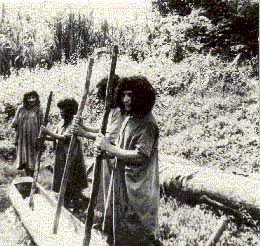
In
the second half of the 19th century, Lacandon traded what they
knew about the rivers and forests with the lumber companies for axes and
machetes. After this contact, they no longer used the stone axe they
traditionally used. However, they do still make the bow and arrow…
however, at the time of the Duby article it was produced more to gain the
interest of traders then to actually use (Duby
277-279).

“The
axe, and machete are used for clearing the forest and cutting firewood,
and the machete is also used for weeding. Planting is done with a sharp
wooden stick. The Lacandon make their dugouts from cedar or mahogany with
an adze, machete, and axe. With a wooden bark beater they prepare the
ceremonial bark used sometimes for shirts and for decorating incense
burners. The tree is cut, the bark cut loose and then beaten with the
wooden beater until it stretches wide and looks almost like leather. A
piece of gourd with teeth cut in it shapes kitchen pots and incense
burners, which the men [construct] without the help of [a pottery wheel
or] open fire.” They make bags out of deer and alligator skins that have
been tanned using mahogany bark. They carve wooden spoons, stools, and
boards for preparing incense pellets. They decorate jicara gourds with
carvings (Duby 285).
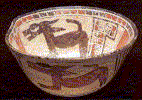
The
Lacandon traded with the chicleros ("gum cutters") and gained
knives, ammunition, shotguns, and flashlights. They replaced bone needles
with steel needles, wooden combs with plastic combs, hand-woven cloth for
cotton cloth, and metates, with which one ground corn by hand with the
corn mill (Duby
279).
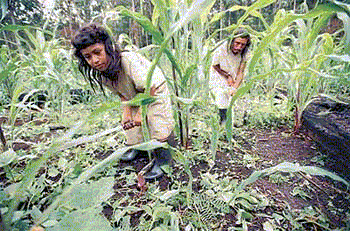
The
Lacandones also gained foreign items through dealings with anthropologists.
“On these rare occasions the Lacandones always acquired things which
would otherwise have been beyond their reach. Naturally at that time, they
had no means of judging the value of products from [western] civilization.
The leader of a Swedish expedition asked one of them what he would like in
payment for some services he had rendered. He left the choice to the
Swede: ‘Give me your flying machine,’ he said, ‘or a dog.’ They
love dogs more than anything else… but where do you get a dog if every
one you see already belongs to somebody? The Swede had almost decided on
the aircraft… because the under-carriage had been smashed on landing. It
did not look as if they would ever get the thing out again, but after a
few weeks they managed to get it out, and they brought a small dog back
from the highlands” (Rittlinger 93-94). The
Lacandon also received cooking-pots, cotton, needles, lollipops, salt,
quinine, waterproof matches, machetes, necklaces, and rubber balls as
gifts or payment from the anthropologists (Rittlinger 94).
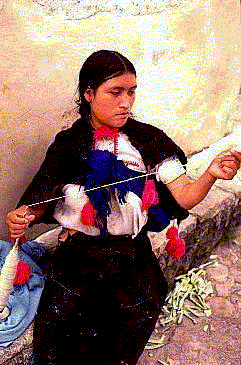
The
women own needles of bone or steel, some have pocket or kitchen knives.
Few own a belt loom, but all use a spindle. They spin thread by twirling
the spindle in a squash bowl. They create a cotón, or coarse
garment, out of 2 strips woven on the belt loom, then are sewn together
with a space left for the head. “Men make tortoiseshell cards that the
women use to extract fibers from the ixtle plant for making string.
“They make nets from bark, which has been soaked for a month in water
and then worked into strings. The same material is knotted for hammocks on
a special wooden frame. Clay pots are supplemented by enamel pots or cups,
gourds serve for drinking. Women make baskets out of vines to store food
for catching small birds and fish, and fires may be started by rubbing 2
hardwood sticks together" (Duby 285-286).

The children play with acorn tops, dolls of clay or soft wood, wooden airplanes, rubber balls and mini bows and arrows (Duby 286-290).

“The bark of the mahagua tree is used for making clothes” (Rittlinger 85).“Both men and women of the Jatate and Cedro-Lacanha groups wear long white tunics reaching almost to the feet.” When the Duby article was written, men were beginning to wear European / American style clothing- pants and shirts, and keep a nice hand-woven tunic for special occasions. Both men and women wear their hair long and loose (Duby 286-287).
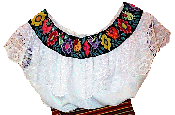
The northern group wears white tunics reaching just below the knees. Women wear brightly colored skirts under their tunics. Women braid their hair and adorn it with feathers when they are married. Women of all groups like to wear many strings of colored beads. Formerly, these were made of berries, jaguar teeth, and vanilla beans, but now they are colored glass beads traded in from the outside world. Some women wear earrings and combs. All go barefoot (Duby 286-287).

![]()
...De Ahora
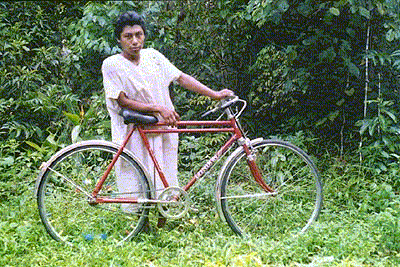
The roads first started to reach the communities in the late 1970's and now there is electricity in all three villages. With the new traffic and television, outside influences have begun to have a major effect the Lacandon. The ways in which the Lacandones have chosen to resist or adapt to change reflects their original sensibilities. Many Lacandons who had never seen an automobile in their youth, today repair their own trucks (Hach Winik website).
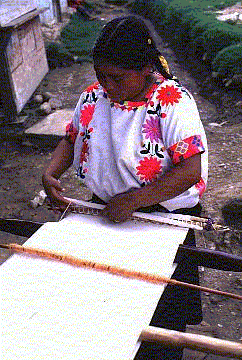
In
the 1950s one could distinguish what area people came from by the
distinctive clothing of both men and women. Now many are buying clothing
in stores, especially the men- many whom today where jeans, T-shirts, and
baseball caps (Familia Maya).

Today, many Mayan buisnesses want the technology to be able to communicate with the outside world. However, they are often denied this. For example. Appel, who works for a U.S. coffee company wants to do business with some Mayan coffee growers, however, they have trouble communicating, since the phone companies refuse to install phone-lines in many Indigenous communities. They say that they don't believe it is "profitable" or they refuse to go into a "conflict zone," and to go talk to the competition- who of course, also say no. Thus, these communities continue to be marginalized (Appel, Jaguar Sun).

![]()